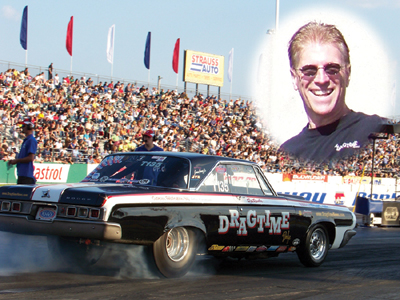| (Article
begins on the Bracket Racing 101 page HERE)
 The
steps a vehicle takes from the point you hit the throttle
to the point the front tires break the beams is akin to
the steps a series of railroad cars take upon acceleration
if all of them started out bunched up as close together
as possible. The engineer hits the throttle, the locomotive
lurches forward a few inches before catching the first car,
which then lurches forward a few inches before catching
the second car, and so on and so forth. The slack has to
be removed from the train before the last car can begin
to move. The
steps a vehicle takes from the point you hit the throttle
to the point the front tires break the beams is akin to
the steps a series of railroad cars take upon acceleration
if all of them started out bunched up as close together
as possible. The engineer hits the throttle, the locomotive
lurches forward a few inches before catching the first car,
which then lurches forward a few inches before catching
the second car, and so on and so forth. The slack has to
be removed from the train before the last car can begin
to move.
In our
drag cars, there are many potential ‘slack points’
that need to be adjusted to have a good reaction time. The
chain could look something like: gas pedal > throttle
cable > carburetor butterflies open > air and fuel
mixture enters combustion chambers and ignites > converter
flashes > transmission > front u-joint > driveshaft
> rear u-joint > ring & pinion > axles begin
to move > sidewalls begin to twist > slicks bite >
energy travels forward through rear suspension to front
end > front end begins to lift > launch. These steps
happen seemingly instantaneously, but when we’re dissecting
seconds into thousandths, there’s a lot of time wasted
at various points along the way.
Although
some of these slack points are beyond our control, there
are three major ones that can be adjusted relatively easily.
The first is launch RPM. I’m of the opinion that you
should launch at the lowest possible RPM that still results
in a good reaction time. If you must go high, the highest
RPM at which I could ever hold a footbrake car on the starting
line was about 1,000 RPM below the stall speed. The next
is tire pressure, both front and rear. Of the two, I feel
the rears have more effect than the fronts. Watch a drag
car leave the line in slo-motion and see how much time is
taken up by the rear sidewalls wrapping up before the car
ever moves. If you want less wrap-up, add more air. On the
rear of the Dodge I run stiff-sidewall Mickey Thompson 31
x 10.5W bias-ply slicks. I run as much pressure as the track
can handle; in the summer when it’s hot and the track
might be slick, no less than 12 lbs.; in September –
October when it’s cooler and the track has more bite,
around 20 – 22 lbs. Last but certainly not least is
front-end travel. One of the things I love about the Dodge
is its torsion-bar front suspension. Armed with a 3/4”
socket, I can make instant changes in the front-end ride
height. I can raise it up to take out travel for quicker
reaction times, or I can lower it to add travel for slower
reactions times. In lieu of having a front-suspension like
mine, many companies sell front end travel limiters. These
can be cable-type or rubber-snubber type. Some companies
like S&W Race Cars sell both.
So what
if you’ve made all the adjustments and still come
up with unsatisfactory reaction times? One possible cause
could be that the car just does not have the low-end torque
and horsepower to be shallow-staged; the next step is to
do some deep-stage testing. Another cause could be using
components that are working against you. Case in point:
on my website The Dragtime News (www.DragtimeNews.com),
I discuss installing ATI’s 8” TreeMaster converter
in the Dodge. You can still read the article on my home
page so I won’t go into the details here, but suffice
it to say that I had been chasing reaction time with varying
degrees of success for years using a 10” converter,
and a simple converter swap was all it took to completely
change the reaction of the Dodge.
I hope
these last two columns have shed some light on reaction
time. Feel free to let me know if you have any questions
or comments.
|



